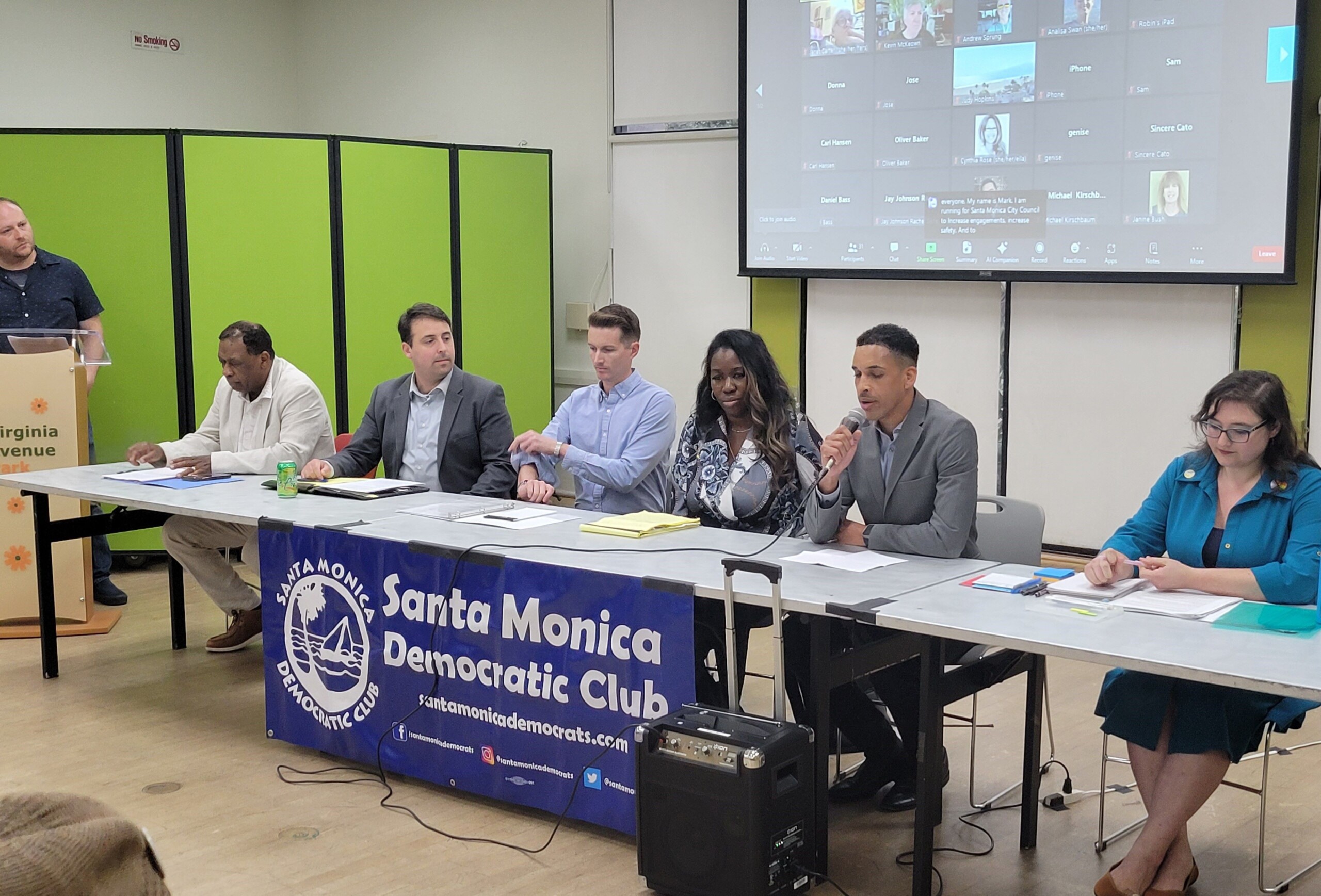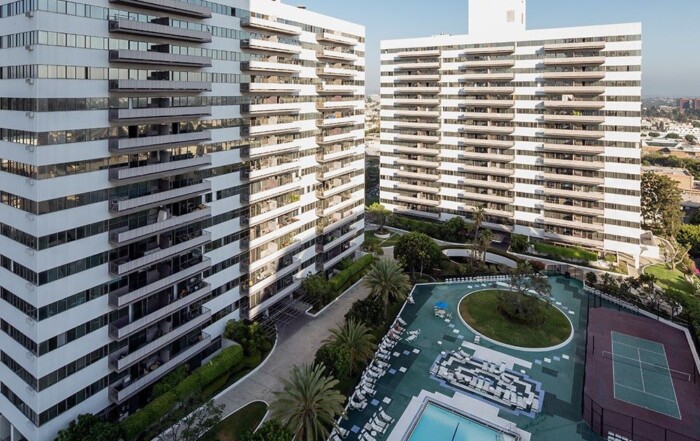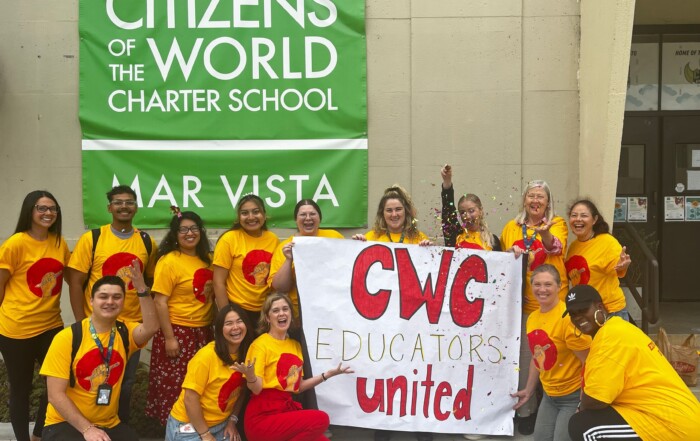Election season has started early in Santa Monica this year as the campaigns for local office – particularly for city council – look to be highly competitive.
Following a successful forum on May 29 that featured candidates for the Santa Monica-Malibu Unified School District Board (SMMUSD), Rent Control Board, and Santa Monica College (SMC) Board of Trustees, the Santa Monica Democratic Club hosted six candidates for city council last week. Their meeting was held in person at Virginia Avenue Park and over a Zoom camera feed. There were about 80 total attendees. The meeting has also been viewed on YouTube close to 240 times since.
With his signature, “Good evening Democrats!” Club President Jon Katz kicked off the debate that would extend beyond two and a half hours. Participating candidates included SMC Trustee Barry Snell, Planning Commission Chair Ellis Raskin, Santa Monica Pier Corporation Board Member Dan Hall, Rent Control Board Chair Ericka Lesley, community builder Marcus Owens, and Former Santa Monica Audit Committee Member Natalya Zernitskaya.
Candidates were given 60 seconds each to respond to a long series of questions about issues facing the city – many if not most challenges facing other local jurisdictions. A candidate could raise their hand if they had an objection or a challenge to anything said by another candidate. Candidates took turns in the order in which they responded to each subsequent question, which unfortunately took up time with only one microphone being passed between Katz and all six candidates.
Dan Hall, who is also an Iraq war veteran and one of two LGBTQ+ candidates for city council along with Zernitskaya, wasted no time challenging the current council majority – none of whom have received previous endorsements for city council from the Democratic Club and who chose to forgo the evening’s debate – saying he’s running to restore progressive values to city hall “Because they’ve been missing for the past four years.”
An environmental attorney, Ellis Raskin said he first got involved in Santa Monica politics fighting evictions in his own Pico Neighborhood. He said “The eviction crisis continues” and said young people who grow up in Santa Monica don’t have any real hope of living here when they complete their education.
Natalya Zernitskaya, a Belarussian immigrant who fled Jewish persecution in the former USSR, said she’s running to “Advocate for a more positive future for Santa Monica.” She shared that she has lived experience with government programs and relying on safety nets. She previously served as Chair of the League of Women Voters of Santa Monica and finished fourth for three available seats for city council in 2022.
Ericka Lesley was quick to remind attendees that they were meeting in the Thelma Terry Center, a wing of the Virginia Park Library dedicated after a former Santa Monica City Employee who fought through racism in decades past. “She has carved the way for me to be here tonight,” she said. She also said she’s here for the young people who are losing faith in the democratic process.
A certified public accountant, Barry Snell has previously served on the SMMUSD Board and has been on the board of Downtown Santa Monica Inc. for 12 years. He’s running to promote a more transparent, inclusive, and equitable city. He wants to ensure safety, affordable housing, and infrastructure investment.
Katz’s first question for the panel was why each thought the other candidates declined an opportunity to seek the Democratic Club’s endorsement.
Hall didn’t mince words. “I think the incumbents are afraid to face challengers because they don’t have much to run on,” he said. “They have a significant amount of broken promises – I have a whole list here, let’s rattle them off,” as he noted several failures in public safety, homelessness, limiting building heights, and triggering the Builder’s Remedy solution through their failure to deliver a compliant Housing Element to the State. The Builder’s Remedy is a drastic state law that allows developers a whole host of building heights and densities when a city is out of compliance with the State’s Housing and Community Development (HCD) Department.
Raskin lamented several incumbents for failing to say whether they’re even running again, saying “If you haven’t made up your mind yet whether you’re going to run or not, I think that’s a serious indictment about whether you’re serious about being a leader in our community.”
Katz then asked the candidates their views on what has contributed to the housing affordability crisis in Santa Monica. Zernitskaya said, “Just looking at the numbers, we have significantly underbuilt new homes for the past several decades.”
Marcus Owens suggested a vacancy tax be placed on landlords who leave apartments unrented. Hall argued that parking requirements make construction too expensive and that wages aren’t keeping up with high rents. Snell proposed establishing nonprofit public banks that would allow the city to pinpoint investment in new housing and programs that help residents stay in their homes. Lesley said we need inclusionary housing requirements of up to 30 percent of all new units designated as affordable, but Raskin corrected her that state law only allows up to 15 percent. But she was unrelenting, saying the city needs to lobby legislators to allow for 30 percent.
“I have lived experience, and I know where the cracks are,” said Lesley.
Zernitskaya pointed to a popular program like “Preserving Our Diversity,” or POD program, which provides financial assistance to seniors so they can age in place, saying, “But it only benefits seniors who are low income. We need to expand that.”
Measure LC, passed by voters in 2014, would close Santa Monica Airport and create a great park on the land. Katz asked the candidates whether or not housing should be also allowed on airport land if the park closes as proposed at the end of 2028. Snell said he supports a park but that we should be using this time to hear from residents about their priorities. He pointed to $20 million the city would receive from the airport that would aid the general fund. Hall said, “I respect and support Measure LC, period. The land should be used for the development of parks, open spaces, public recreation facilities, and the maintenance and replacement of existing cultural arts and education uses.” He thinks there is ample opportunity to build housing elsewhere or in areas around the airport. Raskin largely agreed with this position. Owens said the homelessness crisis is too acute “To only build a park there,” and suggested transitional housing.
Katz then raised whether the candidates support a Statewide Ballot Measure called “The Justice for Renters Act” that voters will decide on in November. The measure would essentially repeal the system of “vacancy decontrol” we have now, where if a rent-controlled unit is vacated, it makes a single jump to the current market-rate rent before being re-controlled until the next vacancy. The Act would return the power of determining rents to local government control. He also inquired what they think the city should do if it passes.
The candidates unanimously support the measure, with Hall supporting a return to vacancy control with an open mind to “rolling rent control,” where developers would have a set period of 15, 20, or 25 years to recoup returns but then all units in their building would join a city’s rent-controlled housing stock. Raskin made the point that no decision should be made unilaterally by the city council without consulting the Rent Control Board. Lesley says vacancy decontrol will require more code enforcement officers if landlords leave problems unattended.
Turning to public safety, Lesley feels more police and code enforcement officers are needed, with Snell saying “Every city needs a strong police department,” but also supports unarmed response to the unhoused population so police can stick to crime. Zernitskaya thought it ridiculous that despite 16 vacancies needing filling in the SMPD, the council majority recently approved a budget allocation for 4 additional officers over fixing streets and sidewalks, and there seemed to be a consensus on that. Raskin was quick to remind the audience that more L.A. county children are dying in traffic right now than from gun violence. Hall thinks the city should fund and better utilize the real-time crime operations center to help police effectiveness against crime.
One big controversy the council majority has increasingly bemoaned is L.A. County’s needle exchange program happening in Reed Park where kids are at play. But Hall said, “A clean syringe exchange program is a proven method for preventing deadly communicable diseases such as hepatitis and HIV.” He added, “We have to go to where the problem is. We can’t expect people to come to a center downtown or somewhere else in our community.” He did acknowledge that the county should be funding park sweeps, however, after a session of needle exchanges has concluded. Raskin pointed out that the hysteria is focused on a program that lasts just two hours a week and happens where it is most needed. Zernitskaya reminded the audience that the program used to take place at three parks and is now down to one. She also stated that the program is more than an exchange. “It also connects people to programs to help them get off of drugs if they are addicted. It helps connect them to other resources they may need,” she said. “It’s saving lives,” said Snell, who didn’t appreciate the public display of protest some city council members participated in recently and whose supporters said openly degrading things about other council members and City Manager David White.
With the idea that a budget “Is a reflection of our values,” candidates discussed city budget priorities. The consensus seemed to be around supporting the schools, housing – including repaying the Affordable Housing Trust Fund – rental assistance, code enforcement, and filling open city staff and SMPD positions. Raskin said there’s real value in investing in rental assistance and housing given that failure to do so costs more on the back end when the rent-burdened become unhoused. Zernitskaya said, “We’ve got $458 million in unfunded capital improvement projects, and a lot of those things are going to save us more money in the long run.” She used the example of fixing a home now versus waiting until later to fix what’s broken, given that the problem has likely grown worse and costlier. She also stated investing in local businesses pays off as their success produces more local tax revenue.
To address the racist taking of land and the destruction of Black and Brown neighborhoods in Santa Monica in the 1950s and 1960s, Snell recommended taking some cues from the State Legislature’s recommendations on reparations. Snell added that his diversity will be an asset, saying, “I’m a strong believer that with myself sitting on the council, I’ll always be looking at those kinds of policies that negatively affect certain ethnic groups.” Lesley referred to the Ebony Beach Club, Silas White’s dream that was taken away through eminent domain in 1960. “It needs to be not just that the land be given back, but there’s so many years of equity that have been lost by that family,” she said. And with Raskin and Hall saying they support a “right to return” to previously owned family assets, she said, “The ‘right to return’ is nice, but it’s not nice for people that lost their homes that they owned.” She added, “You cannot replace a home that was owned by a unit you can rent.”
On mobility, there appeared to be consensus on public transit issues but the focus was on street safety. Lesley, a mother of three boys, surprised some audience members with news that one son was struck by a vehicle recently, was impaled, and that she’s been going back and forth to the hospital for a month. Speed humps, street narrowing, or “calming,” and raised and daylighted sidewalks were all options the candidates would consider. Snell was very pleased to see the work to create a right-turn-only environment all along Wilshire Blvd.
The evening ended with a fun question about where each candidate would take a visiting friend to show them why they love Santa Monica, followed by closing arguments. Location recommendations ranged from Gilberts El Indio and other restaurants to the Pier, the beach, the Santa Monica stairs, and Virginia Avenue Park itself.
Photo by the author.
Stay informed. Sign up for The Westside Voice Newsletter
By clicking submit, you agree to share your email address with Westside Voice. We do not sell or share your information with anyone.








